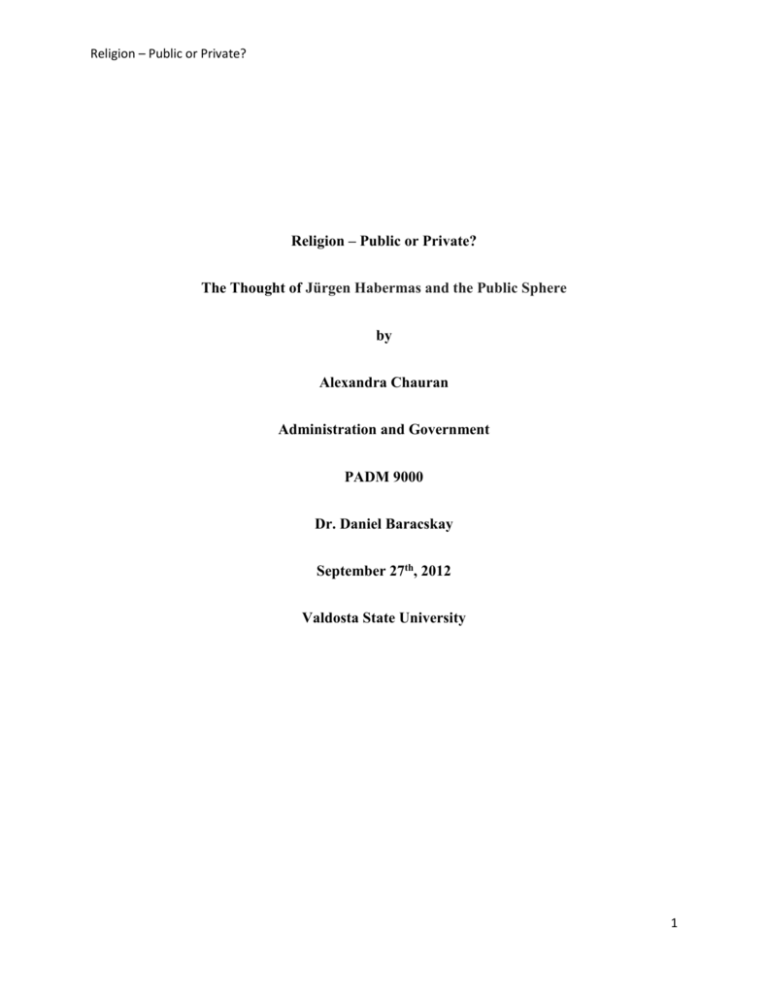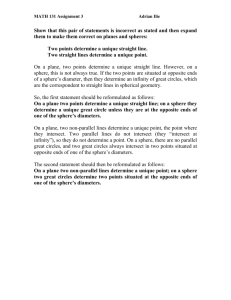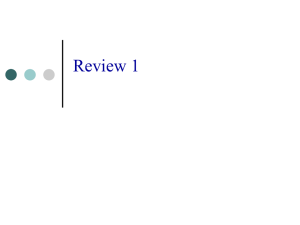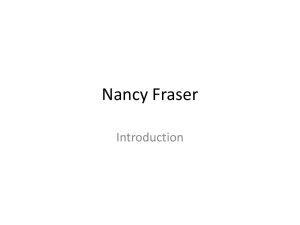Religion – Public or Private? Religion – Public or Private? The
advertisement

Religion – Public or Private? Religion – Public or Private? The Thought of Jürgen Habermas and the Public Sphere by Alexandra Chauran Administration and Government PADM 9000 Dr. Daniel Baracskay September 27th, 2012 Valdosta State University 1 Religion – Public or Private? Introduction Summary of the thought of Habermas and the Public Sphere In the beginning, there was representation. Habermas thought that the first public sphere was not truly a democratic reflection of the public at large. Rather, the public sphere consisted of ideas that were consciously given to the public by an authority figure such as the church. After the enlightenment, when individual reason was valued, only then did the public sphere begin to represent a more democratic mixture of ideas, as people came together in coffee shops, Masonic Temples and other public places to discus and debate public issues at length. Habermas thought Britain was the most liberal, and indeed it experienced a cultural revolution along with much of the globe that included modernization, mass commercial media and interest groups. Why this idea is important to the study of Public Administration The idea is important to the study of Public Administration because the distinction between the “public sphere” and the “private sphere” is waning in the current paradigm in which we are working (Henry 1975, 383). I have chosen to examine the influence of religion on the public sphere. Habermas says that religious input into the public sphere is just as valid as secular rational thought (Butler et al 2011, 61). He points out that a lack of shared language can be a confounding point in interfaith dialogue. Habermas also points out that a basic difference in culture and the way that people approach knowledge within their religion, revelatory versus experiential mystery traditions can influence both their interaction with the public sphere and their attitudes toward government (Butler et al 2011, 62). He asks, can we say that the differences between people of different religions are philosophical? Are they ethnic or cultural (Butler et al 2011, 67)? 2 Religion – Public or Private? Expanding the Text Are Religious Groups Separate Public Spheres? Is the boundary between public and private deteriorating or strengthening? As interest groups, particularly faith-based interest groups, gain interest, there is a fracturing of the public sphere. As there is a wall between public and private life, and religious life is seen as private, interest groups are able to flourish and gain influence without interacting with one another significantly except to challenge one another for legitimacy (Lowi 1967, 16, 18, 20). Rather than one interest group gradually phasing in while another phases out, there are many that exist concurrently, and continue to persist even when specific issues at their forefront change. For example, the issue of gay marriage is a topic currently in debate in the public sphere, but before that it was the issue of gays entering the military, largely argued by the same interest groups. Over time, the issues themselves lose context, so that it is wondered by some as to whether the religious doctrines actually do speak to the politics or whether it is the other way around through the magic diversion of attention tricks that the public sphere can play. As the representation of the public sphere by the Catholic and Protestant churches began to give way to minority religions, the way that religion glued society together began to change. Some scholars believed that, instead of a united church state, the secular state would be made up of smaller, social religious groups. The lack of hierarchy was hoped to form a society without classes, neither servile to the representative public sphere nor subject to group ideologies (Urban 2004, 13, 17). In modern America, the denominational divide does not only represent beliefs and ideologies, but can also betray other important differences between people from geography to 3 Religion – Public or Private? race (McCloud 2007, 1442). In other areas of the globe, race is an even bigger factor in religious disagreements, but that is growing in America with a rise in Islamic ideology in politics (Meyer & Moors 2006, 92). The political climate of America may be affecting the way that churches as interest groups swell and decline. For example, the appearance of “megachurches,” which are generally accepting of large numbers of people with fewer ideological banners, may be a refuge for more liberal or even secular Americans. Can this be a large opportunity for engagement of many in a public way without representation, or is the church still private and divisive? In the case of the megachurch, people may seek to avoid confrontation on specific issues, in order to value fellowship. Conversely, some interest groups form under the banners of several different denominations. For example, the movement toward the legislation of gender dependent marriage laws has been pursued independently by a great number of Christian churches, with separate non-profit interest groups formed that are backed financially by several churches (McCloud 2007, 1443). Is this strengthening the public sphere and interest groups, or making them weaker? It can be argued that any lack of consensus weakens the influence of religion, no matter whether the lack of consensus be in denomination or in ideology (Wildavsky 1988, 753). Furthermore, where does popular culture end and religion begin? In the debate about schools using terms like “Merry Christmas” lacking the separation between church and state, the public may give a great outcry that many religious traditions have firmly entered the realm of the secular (McCloud 2007, 1444). How can promotion of a religion be kept separate from the state while allowing the free discourse of the public sphere? After all, many religious traditions have firmly entered the realm of the public. 4 Religion – Public or Private? Are mystery religions opting out of the public sphere or helping it endure? A key component of some religious traditions is secrecy and keeping the religious life private. Mystery religions continue the initiatory experiences similar to those of the Eleusinian mysteries of ancient Greece. If a spiritual experience is designed to be something incommunicable and perhaps a one-time event in the life of a practitioner, sharing details about the practices are not allowed, since they would be at best inadequate and at worst, spoil the surprise (Ceraso 2008, 234). In a modernized world where one can learn about so many religions with the click of a button or turn of a page, and even be ordained by the Universal Life Church online, mystery religions maintain a vital in-person component that cannot be eliminated. Secrecy reintroduces some geographical limitations to groups when travel or local living is required for specific religious rites. For example, in traditional initiatory Wicca, it is against the religious code to reveal the name or number of other practitioners of the religion, despite many of them choosing to speak freely about their own individual practice on the Internet (McCloud 2007, 1448). This presents a conundrum if estimates of the number of religious practitioners need to be made, for example in order to allow for the hire of military or prison chaplains of the appropriate denomination. The vows to privacy taken by Wiccans also means that by the very nature of their religion they must enter the public sphere as individuals, rather than having the support of a large religious organization that starts taking the form of a political interest group (Gripsrud et al 2010, 21). In the case of ritual drug use or sex, such secrecy can also serve to shield religious practices from the public sphere and the critical eyes of politicians. Such scarcity of information can add to public hysteria, however, when for example the practical safety tips are not passed 5 Religion – Public or Private? along with the rumor of the use of entheogenic drugs. The question also arises as to who controls the information flow? Perhaps secrets kept by religious traditions are one way of introducing the power of a representative public sphere without obvious power plays that would be rejected by a post-enlightenment public (Cesaro 2008, 241). If religious information were to become public, who would prevent the control of the information by corporations looking to make products to capitalize on the public interest? Minority religious traditions that included witchcraft exploded into the public sphere with media coverage when the Witchcraft Act was repealed in Britain in 1951, making the practice of witchcraft no longer a crime. Of course, the media highlighted the most sensational aspects and cultural contradictions of the modern proponents of witchcraft, such as the use of sex and drugs in ritual, which went against public values. Magicians such as Aleister Crowley stole the public spotlight with stunts like claiming that his previously written books had predicted the events of the world wars, and had tried to influence first Hitler and then British leaders in order to spread his political ideas (Urban 2004,10). In a sense, the media seized on something that was mere entertainment, as well as a growing edge of a modern era that Habermas observed was disillusioned by war (Urban 2004, 18). Witchcraft represented a secret shadow of the culture that had existed all along as well as reflecting the more imminent desire for society to throw off the shackles of oppressive norms (Urban 2004, 11). Crowley brought the issue of womens’ sexual power to the media forefront as well, since women were often given egalitarian roles in religions that included witchcraft, and ritual nudity and sex made sexual desire and influence by women undeniable (Urban 2004, 16). Since witchcraft was an orthopraxic, rather than orthodoxic, aspect of emerging minority religions, it also appealed to the modern obsession with empiricism and positivism. Crowley 6 Religion – Public or Private? wrote The Scientific Solution to the Problem of Government in order to promote metaphysical systems to bring about individual freedoms (Urban 2004, 18). If written media, radio and television and now the Internet seize on the most sensational aspects of minority religions to bring to the forefront of the public sphere’s dialogue, are they actually finding meaningful issues for the public at large? Are religions killing freedom and debate or protecting them? Religions have traditionally been associated with the public sphere by representation, and to some extent that still takes place. For example, the Unitarian church opposed slavery as a whole in (Ormerod 2006, 895). However, as the enlightenment shifted the focus from revealed religions like Calvanism to the ideas of transcendentalism and reasoning based on natural observations and experience, individual religious people entered the public sphere. Speaking in their own right, they no longer needed the backing of a church to have their views recognized as valid by their peers. (Ormerod 2006, 895). Aleister Crowley was very expressive about individual freedom, reflecting and adding upon Kant’s post-enlightenment “dare to know” with his own catch phrase, “do what thou wilt Urban 2004, 16).” It is thought that Crowley’s notion of the “will” represented one’s true essential drives and destiny, rather than a passing whim. Therefore, those who were following their true wills would be doing what was right for them in the grand scheme of their time on earth. Similar to the individualist Anarchist movement, Crowley’s contemporaries believe that when everyone is fully able to express their wills in the public sphere, debate and dialogue will be a learning evolution for all, and those with the best ideas and strongest wills will win favor among or legitimate power over all the rest (Baradat 2012, 155). 7 Religion – Public or Private? Critical Analysis How Habermas’ thought relates to government and systems of administration Pragmatists have believed in the separation between church and state because religious differences can cloud issues and because spirituality is at best a moot point. If everyone should have the right to practice his or her own religion freely, then what does it matter what religions have to say about any issue? Let each man or woman guide his or her own heart accordingly. However, one can never completely separate church and state because the church exists within the state and they both influence the public sphere significantly. In this critical analysis, I’d like to go through a few key examples of common clashes between church and state that plague public administration. Traditionally, recognition has not been a problem for churches. The influence of large religious hierarchies have had to be pried kicking and screaming away from the state, and in many cases the separation has not been successful. Thus, it would be impossible to dispute the validity of a powerful church as a religious organization. However, as newer religious groups gain followers and influence, their legitimacy can be questioned greatly, especially if they differ significantly from existing social and religious norms (Robbins). Recognition by the state is important for several reasons. Tax exemption is one issue. Churches are exempt from paying taxes to the IRS because such influence of the government over religions might compromise freedom of religion. Interestingly, however, through the tax exemption process the IRS is able to exert some control over religious bodies. For example, in order for a religious organization to be tax exempt, a significant amount of its activities cannot be political, such as the promotion or criticism of a law or political candidate. 8 Religion – Public or Private? At first glance, such a rule may seem to be against our values of freedom of speech. However, if large churches were able to preach a candidate from the pulpit while remaining tax exempt, it could compromise the fairness of the election process. Another example of the tricky business of state recognition is in the performance of state recognized marriages. On the liberal end of the interpretation of common tradition is the State of Washington. Anyone who is ordained in any denomination is automatically recognized as clergy by virtue of the relationship of the clergy member to the individuals being married, not the state. However, in other states, the language can be more specific. Instead of any clergy of any denomination, laws may specify a priest or minister of the gospel who is in communication and good regular standing with a regularly established church and whose marriage ceremonies won’t interfere with ministry and regular services. Instead of allowing the couple to be wed to recognize a clergy member, the state may require proof of ordination on file, or even a letter from the church headquarters. In religious practices such as Wicca, where there is no central authority, acquiring such a letter legitimately would be quite impossible. While we are on the topic of marriage and family law, churches can influence their followers by making it easier or more difficult to receive marriage or divorce within a denomination (Meyer & Moors 2006, 115). Sure, a couple could get married by a judge, but in the eyes of their tiny corner of the public sphere, their marriage may be seen as invalid. One of the arguments for legalizing gay marriage in the state of Washington is that no churches would be forced to perform the marriage ceremonies. Thus, it is argued, that members of those churches should not have an opinion about whether gay people should marry. Of course, those 9 Religion – Public or Private? individuals are still a part of the public sphere, and have an opinion about what actions are right or wrong outside of their church as informed by their faith traditions. Another aspect of family law is the public opinion of religions when granting the custody of children. In numerous cases, those who practice witchcraft as a part of their religion have had children removed from their care by a jury. For Hegel, public opinion was a problem as much as it was necessary, to be both “respected” and “despised.” Certainly that public hive mind plays a role in every judicial decision since no judge can be raised without the influence of the public sphere. The state and religions also clash about the care of children when it comes to health. Jehovahs Witnesses and Christian Scientists are particularly at the center of the right of children to receive adequate health care (Robbins 2001, 181). Jehovahs Witnesses do not receive blood products like transfusions as a result of their religious beliefs, which becomes an issue if a minor requires a blood transfusion to live and the parents refuse treatment. To an even greater extreme, Christian Scientists refuse nearly all medical care, instead relying on the power of healing prayer and avowing that all illness is simply an illusion that can be willed away with the power of the mind and God. Christian Scientists struggle to have Christian Science Practitioners, prayer healers, recognized by the state in order to have their services paid by state and federal health care. A Christian Science Practitioner’s time praying can already be paid for with Medicare, however Christian Scientists are still prosecuted if their children die as a result. Another issue that may affect public health is the use of illegal entheogenic drugs. In can be observed that entheogenic drugs are widely prohibited and yet enjoy wide circulation. The 10 Religion – Public or Private? problem with keeping entheogenic drugs illegal is not only a potential waste of taxpayer money if they are found to not be dangerous, but also the restriction of those drugs for positive uses as pharmaceuticals and for traditional religious purposes. Efforts to protect the religious use of entheogens have been fraught with difficulty as opportunistic recreational users of drugs could easily establish a fake acid church in order to continue their enjoyment of LSD. The problem of state recognition of religions arises again in court cases. If an indigenous religious tradition is seen to have a central use of the drug for a long time, and have other interests as well, the use of the drug can be seen as valid. However, the public has been notoriously alarmist about children or teenagers using any drugs recreationally, regardless of other uses for the drugs concerned. Regardless of the legality of entheogens, they persist as an enduring way for many people to experience spirit. The mystery of entheogens is not public, and yet many individual members of the public sphere have experienced the mystery. Scholars pose the question: How do you form a public mystery (Ceraso 2008, 241)? John Stuart Mill wrote that any silenced opinion must contain some kernel of truth within it, and when that is removed from the public sphere, it tilts the debate in the favor of untruth (Gripsrud et al 2010, 21). Freedom of speech issues may also swirl around the truth or untruth of religious practices. Currently there are 17 states that have laws against fortune telling, which is a central and vital practice of many religions (Robbins 200, 182). In most cases, all fortune telling or at least fortune telling for money is considered to be fraud. However, there are various religious traditions, including Hatian Vodou and American Hoodoo, in which functions such as fortune telling is the only way that the clergy earn a living. 11 Religion – Public or Private? Should all be banned in the name of protection from fraud? What about people who believe in the truth telling of their sooth sayers? Other states have repealed laws against fortune telling wholesale based on the freedom of speech issue alone. With commercial mass media brings a new influence of religion on corporations and influences of the corporate world on religions (Robbins). Scientology, for example, is a religion with a greater corporate structure than it has a set of practices. Entirely without worship, Scientology emerged as a product and nevertheless gained many ardent and sincere followers. Subsequently, Scientology has sought to influence governments and interest groups worldwide on topics pertinent to their beliefs, particularly religious freedom. (Robbins 2001, 175). Sometimes the ideas of the church are sold as a product without the church being sold as well. In the case of the aforementioned debate on gay marriage, church leaders have formed groups such as Focus on the Family, which are largely corporate in nature and structure, relying heavily on advertisements for donations to further their causes. Much like a commercial organization, they develop campaigns for specific products and engage their community as consumers, forming focus groups to talk about the effectiveness of radio advertisements and educational materials for children. The effects of modernization have changed the way that religious organizations and religious people interact with the public sphere. While some withdraw from and fragment heir own public spheres, others increase influence by embracing commercialization and the mass media. People turn to religious organizations when empirical data is not necessary or sufficient to make a decision based on values. Whereas church can somewhat be separated by state, one cannot extract morality from religion, and one cannot extract ethics from the state. 12 Religion – Public or Private? Concluding Statements Major Points My major points come in the form of questions, the definitive answers for which are beyond the scope of this short paper. However, they can be distilled to the following additional aspects of the thought of Habermas and the Public Sphere: (1) Are religious groups separate public spheres? (2) Are mystery religions opting out of the public sphere or helping it endure? (3) Are religions killing freedom and debate or protecting them? Summary At first, representation in the public sphere by church leaders was obvious, but now the effects of religion on the public sphere may be more subtle but just as widespread. Habermas said that the public sphere began to decline due to global communication and media, but there can never be complete globalization of some religious practices, which helps the public sphere endure. Conversely, the stifling of debate that may happen due to strict beliefs can also compromise the usefulness of the public sphere. As religion continues to find niches in our modern world, each individual in the public sphere is left to discover whether to allow faith to inform his or her values and contribution to the public sphere. Bibliography Baradat, Leon P. 2012. Political Ideologies Their Origins and Impact 11th Edition. Englewood Cliffs: Prentice-Hall. Barna, B. 2010. “The Beas With Two Backs.” Blackbook Magazine. (81), 38. 13 Religion – Public or Private? Butler, J., Mendieta, E. & VanAntwerpen, J. 2011. The Power of Religion in the Public Sphere. New York: Columbia University Press. Ceraso, A. 2008. “Entheogens and the Public Mystery: The Rhetoric of R. Gordon Wasson.” Configurations, 16(2), 215. Gripsrud, J., Murdock, G., Moe, H. & Molander, A. 2010. The Idea of the Public Sphere: A Reader. Kindle Edition. Lanham: Lexington Books. Henry, N. 1975. “Paradigms of Public Administration.” Public Administration Review. Vol. 35, No. 4. July-Aug. pp. 378-386. Lowi, T. 1967. “The Public Philosophy: Interest-Group Liberalism.” The American Political Science Review. Vol. 61, No. 1 pp. 5-24 McCloud, S. 2007. “Religion and Modern American Culture. Choice: Current Reviews For Academic Libraries. 44(9), 1439-1451. Meyer, B. & Moors, A. 2006. Religion, Media, and the Public Sphere. Bloomington: University Press. Ormerod, R. 2006. “The History and Ideas of Pragmatism.” The Journal of the Operational Research Society. 57(8), 892-909. Robbins, T. 2001. “Introduction: Alternative Religions, the State and the Globe.” Nova Religio. 14 Religion – Public or Private? 4(2), 172. Wildavsky, A. 1988. “Ubiquitous Anomie: Public Service in an Era of Ideological Dissensus” Public Administration Review.Vol 48, No. 4 (Jul-Aug), pp 753-755. 15








